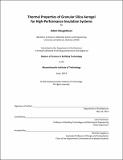Thermal properties of granular silica aerogel for high-performance insulation systems
Author(s)
Neugebauer, Adam (Adam Halbert)
DownloadFull printable version (2.157Mb)
Other Contributors
Massachusetts Institute of Technology. Department of Architecture.
Advisor
Leon Glicksman.
Terms of use
Metadata
Show full item recordAbstract
Based on mounting evidence in support of anthropogenic global climate change, there is an urgency for developments in high-performance building techniques and technologies. New construction projects provide substantial opportunities for energy efficiency measures, but they represent only a small portion of the building stock. Conversely, while existing buildings are plentiful, they typically have a much narrower range of feasible energy efficiency options. Therefore, there will continue to be a need for the development of new and improved energy efficiency measures for new building construction and even more so for deep retrofits of existing buildings. This thesis provides an overview of the research performed into the on-going development at MIT of a high-performance panelized insulation system based on silica aerogel. Two test methods were used for measuring the thermal conductivity of the granules: the transient hot-wire technique and the guarded hot-plate system. Utilizing the hot-wire set-up, it was demonstrated that compressing a bed of granules will decrease the thermal conductivity of the system until a minimum point is reached around the monolithic density of the aerogel. For the Cabot granules, this was seen at 13 mW/m-K and about 150 kg/m3. The MIT granules showed equal performance to the Cabot granules at bed densities 20-30 kg/m3 lower. The hot-plate testing was able to experimentally evaluate previous analytical predictions regarding the conductivity impact of the internal panel truss and the under-prediction of radiant heat transfer in the hot-wire method. Hot-wire testing was also done in a vacuum chamber to quantify potential performance improvements at reduced air pressures. Since a vacuum would require the incorporation of a barrier film into the panel system, some analyses were done into the thermal bridging potential and gas diffusion requirements of such a film. Additionally, physical prototyping was done to explore how the film would be incorporated into the existing panel design. The aerogel-based insulation panel being developed at MIT continues to show promise, though there are still plenty of opportunities remaining in the development cycle.
Description
Thesis: S.M. in Building Technology, Massachusetts Institute of Technology, Department of Architecture, 2013. This electronic version was submitted by the student author. The certified thesis is available in the Institute Archives and Special Collections. Cataloged from student-submitted PDF version of thesis. Includes bibliographical references (pages 65-67).
Date issued
2013Department
Massachusetts Institute of Technology. Department of ArchitecturePublisher
Massachusetts Institute of Technology
Keywords
Architecture.